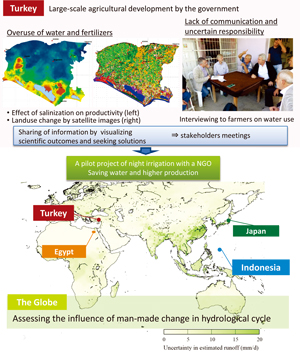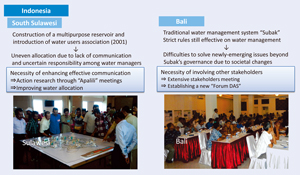Designing Local Frameworks for Integrated Water Resources Management
- C-09
- CR①
- CR②
2017
KUBOTA Jumpei
RIHNCo-Project Leader
Dorotea Agnes RAMPISELA
Hasanuddin University>> Annual Report
>> Project's Page

Figure 1 Progress of the project at a glance. The map in the center indicates the uncertainty indicated by a model predicting water runoff, on which the key elements of research problems and findings in the case study sites on water resources management are featured. Deeper green color signifies higher uncertainty in estimating water resources, and demonstrated the need for transdisciplinary approaches to local-level co-creation of water knowledge and resource management.

Figure 2 The results of stakeholders meetings in Indonesian study sites
Background and objectives
The concept of Integrated Water Resources Management (IWRM) was first proposed in the 1990s in order to recognize and coordinate the many stakeholders and sectors involved in water resources management. While IWRM has focused on integrating the sectors and organizations governing water resources, it has not typically been able to incorporate demands from local water users or taken account of their cultural or historical backgrounds. New frameworks or guidelines have been requested in the field of local-to-regional water resources management.
The objective of this project is to propose knowledge structures and functions of water resources management to local-level stakeholders who play the essential role in adapting IWRM into society. The research therefore involves considerable exchange between the scientific study of water cycles in particular places and the wide range of stakeholders involved in water management and use. The project’s goals are to develop cooperation between science and society in order to stimulate the co-creation of desirable local water resource management.
Achievement
In order to accomplish the goals of the project, we established several study sites in Indonesia, Turkey, Egypt and Japan. Project research put special emphasis on sites in Indonesia and Turkey as they present a simple hydrological contrast between humid and arid regions, while their historical and cultural differences offer comparative examples of water management structures. We held stakeholder meetings and conducted action research in field study areas in order to promote mutual understanding of how different actors perceive water related problems and to seek new ways of establishing proper water resources management.
In Indonesia, field surveys in the subak systems of Bali indicated recent changes in their societal functions and roles related to globalization and mass tourism. At the same time, a stakeholder meeting held in Bali in 2013 demonstrated that problems such as water pollution caused by illegal waste dumping and illegal constructions on irrigation canals have recently arisen between subak members and outsiders. Through intensive dialogues among stakeholders, the project established a new “Forum DAS” (river committee) including subak representatives, officials and engineers in local governments, scientists, and NGO workers in order to address these problems beyond the normal scale of subak governance. In South Sulawesi, a lack of communication among water managers was clearly identified in the stakeholders meeting in January 2014, in which almost a hundred farmer leaders, water managers, and governmental supervisors participated. After this meeting, the project supported further autonomous discussion among water managers by utilizing the traditional “apalili” meeting. These meetings established a detailed schedule of water allocation which was then shared with water managers and farmers, improving the performance of water allocation and, consequently, rice production in 2014. In 2015, this method was applied to other irrigation districts,
In Turkey, we identified similar problems in water management, including information disparities and unclear responsibilities in spite of privatization. Excessive use of irrigation water and chemical fertilizer was responsible for degradation of watershed environment and land productivity. After a stakeholders’ meeting in March 2014, we conducted a pilot project on night irrigation with WUAs, NGO and a private financing agency, in order to address over-irrigation and resulting decrease in production. This project was very successful, reducing water used for irrigation by more than 30 %, while improving production by 26%.
